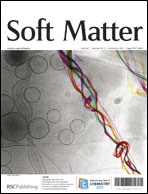A number of fascinating properties of micro/nano-fibers can be obtained as their fine-structures are tuned. Here, we report a one-step procedure to construct nanoporous polystyrene (PS) fibers loaded with controllably distributed silica nanoparticlesvia tuning the solvent compositions in electrospinning. With decreasing solvent vapor pressure in electrospinning, the silica nanoparticles were clearly observed to be transferred from the interior of the PS fiber to its surface due to the phase separation of fluid jet in varying degrees. The silica nanoparticles embedded in the fibers exhibited porous cores contributing to an increase in Brunauer–Emmett–Teller surface area of the as-spun fibers. The presence of silica nanoparticles on the fiber surfaces enhanced the surface roughness with numerous papillae. Water droplets on a typical fiber surface readily sat on the apex of papillae because the air filled in these hierarchically roughened fibrous mats as a cushion, and therefore, displayed superhydrophobicity with a water contact angle of 156.7°. We believe that the exploitation of such a simple method for fine-controlling structures of micro/nano-fibers will endow these materials with new properties for some special applications such as in novel easy-cleaning coatings, microfluidic devices, and even smart membranes.

You have access to this article
 Please wait while we load your content...
Something went wrong. Try again?
Please wait while we load your content...
Something went wrong. Try again?


 Please wait while we load your content...
Please wait while we load your content...